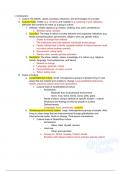I. Introduction
➢ Culture: the beliefs, values, practices, behaviors, and technologies of a society
A. Cultural Traits: Visible (e.g. temples) and invisible (e.g. believing in god, attitudes)
attributes that combine to make up a group’s culture
1. Artifacts: Visible objects (e.g. houses, clothing, toys, tools, architecture)
a. Birthday cakes, dresses
2. Sociofact: The ways in which a society behaves and organizes institutions (e.g.
family, school/education, government, religion, land use, gender roles)
- Slower to change than artifacts
- The institutions and links between individuals and/or groups
a. Family: talking back to family, sepaade tradition in Kenya (woman could
not marry before brothers married)
b. Government: voting rights
c. Gender roles: woman get less education
3. Mentifacts: The ideas, beliefs, values, knowledge of a culture (e.g. religious
beliefs, language, food preferences, and taboo)
- Slowest to change
a. Language: gestures, noises
b. Food preferences: no meat, no pork
c. Taboo: eating dogs
B. Types of Culture
a. Local/traditional culture: Small, homogeneous groups of people living in rural
areas that are isolated and unlikely to change. Long-established behaviors,
beliefs, practices passed down from generations.
1. Cultural traits of local/traditional culture
- Architecture:
- Materials from local physical environment
- Snow, mud, stone, bricks, wood, pelts, grass
- Sense of place: Unique attribute of specific location - cultural
influences and feelings evoked by people in a place.
Distinctiveness.
- Languages, food, ceremonies, customs
b. Global/popular/universal culture: Large, heterogeneous groups of people, often
living in urban areas that are interconnected through globalization and
internet/social media. Quick to change. Time-space compression.
1. Cultural traits of Global/Pop culture
- Architecture
- Glass, steel, drywall, cement
- Land-use:
- Urban and suburban
a. Among Us, TikTok, Youtube, Fashion trends
- Societies with relaxed cultural norms embrace popular culture
, - Placelessness: loss of uniqueness of place. One place looks like
the next or does not inspire any strong emotion or cultural ties.
Uniform landscape
C. Attitudes Toward Cultural Difference
➢ Cultural norms: Agreed upon cultural practices, standards, patterns that guide the
behavior of a culture/group of people
➢ Cultural taboos: behaviors heavily discouraged by a culture
➢ Ethnocentrism: Judging other cultures in terms of one’s own standards and often
includes the belief that one’s own cultures/ethnic group is superior to others
- Could results in clear discrimination
➢ Cultural relativism: An unbiased way of viewing another culture
- Leads to view: no one culture is superior to another culture when
compared
- Critics: How is it appropriate to accept extreme cultural practices (e.g.
violations of human rights) as long as context is understood?
Case Study - Wisconsin’s American Indian Nations
Issue: State of Wisconsin officially recognizes cultural significance of Wisconsin American
Indian Nations that has affected the state’s own cultural values and practices.
General Information:
- State of Wisconsin and tribal leaders passed Wisconsin Act 31 in 1989
- To combat misunderstandings and misinformation
- To bridge cultural gaps and develop unity through mutual respect and
understanding
- 50,094 American Indians and Alaska Natives live in Wisconsin (as of 2017)
- 11 federally recognized tribes in Wisconsin (as of 2019)
- 12 states observe Indigenous Peoples’ Day (as of 2019)
Honoring American Indian heritage:
- St. Norbert College in Wisconsin adopted a land acknowledgement statement in 2018
- Governor Tony Evers signed an executive order in 2019 to declare state’s first
Indigenous People’s Day
II. The Cultural Landscape
➢ Cultural Landscape: Natural landscape that has been modified by humans, reflecting
their cultural beliefs + values (e.g. Eiffel Tower, Great Wall of China, Great Pyramids)
❖ Combinations of:
- Agriculture and industrial practices
- Religions and linguistic characteristics
- The Kaaba: square stone building in center of Great Mosque in Mecca
➢ Pilgrimage: A journey to a holy place for spiritual reasons
, - Hinduism temples: house shrines devoted to certain gods
➢ Toponym: Place names that help define what is unique about a place
- Evidence of sequent occupancy
- Traditional and postmodern architecture
➢ Traditional Architecture
- Established building styles of different cultures, religions, and
place
- Reflect local traditions
- Usually evolves over time to reflect environmental, cultural,
historical context
➢ Postmodern Architecture
- Emerged in 1960s as reaction to “modern” designs
- Postmodernism: “a desire to make architecture a vehicle of
cultural expression”
- Land-use patterns
➢ Sequent Occupancy: Idea that societies/cultural groups leave cultural imprints when
leaving a place. Contributes to overall cultural landscape over time. Mix of modern and
historic.
- Example: New Orleans
- Inhibited values, economic practices, languages, customs into landscape
A. Patterns in Cultural Landscapes
1. Attitudes toward ethnicity and gender including the:
- Role of women
- Gendered spaces (e.g. genderless bathrooms in Sweden, gender divided
bathrooms in U.S.)
- Ethnic neighborhoods
Help shape use of space in given society
➢ Ethnicity: Sense of belonging or identity within group of people bound by
common ancestry and culture. Different than race (physical
characteristics)
2. Ethnic neighborhoods/Enclaves: area within city occupied by distinctive minority
culture (e.g. China Town)
- Connects to chain migration
- Why do they form?
- Response to racism and discrimination
- Way to maintain cultural identity
Case Study - Tehrangeles
Issue: Connection of Iranians living in LA community known as Tehrangeles forms cultural
landscape that preserves some of native language and traditions
Tehrangeles





